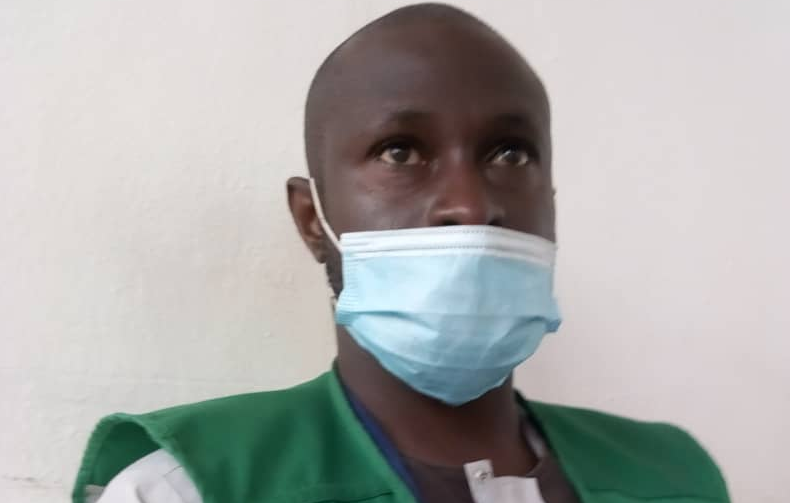Situated on Ibadan-Ijebu Ode road, Onipe village is an agrarian community in Oluyole local government area of Oyo state. It has no electricity or pipe borne water supply and the dwellers are majorly farmers and petty traders. Apart from Onipe, there are about 40 other villages in the area, all relying on two primary health centres.
Frolence Opaleye, a 76-year-old wife of the baale (community head) is a drug dispensing volunteer for these communities. She has been on the field for more than 20 years, helping government and international health agencies to distribute certain categories of off-the-shelve drugs to people afflicted with neglected tropical diseases and other ailments.
Among the drugs the septuagenarian helps to distribute is Mectizan, which is used in the treatment of Onchocerciasis, also known as river blindness, one of the several Neglected Tropical Diseases in Nigeria. She also helps distribute Albendazole, a medication used to treat tapeworm infections such as neurocysticercosis and hydatid disease. These are two of the prevailing NTDs in the communities.
But lack of incentive to compensate for her effort is discouraging Opaleye and other volunteers from carrying out the task, putting victims of these diseases at the risk of not getting the required drugs for treatment. Opaleye is the leader of the volunteer team in the area and each time drugs are brought to her for distribution, she gets N1,000; the same amount is also given to each of the volunteers she engages.
Advertisement
She said she used to have several women volunteers in her team, but because they were not adequately compensated, the women left her to continue alone.

“I am a volunteer for the distribution of drugs to people who need them in communities that government cannot reach. We have several streams in the villages under these communities. There are also Fulani herdsmen in these communities so we have flies from their cattle which transmit river blindness to and other diseases to humans. In these communities, there are victims of these diseases. Many people have been cured with the free drugs supplied by government and distributed by the volunteers to them,” she said.
“We have also distributed other drugs that had helped women to conceive. Unfortunately, our people do not realise how much effort it takes for volunteers to reach them; they think we have been adequately paid for the job.
Advertisement
“I hardly find people to work with me again. Majority of the volunteers are women and I had to beg their husbands to allow them do the work as if it is my personal business. They (the husbands) do not see it as volunteer work. Each time the women distribute drugs to those in need in the villages, I must give them little money for transportation from my own pocket.
“Sometimes I hire commercial motorcyclists to take them to the villages. We are paid N1,000 each for the work but it is too small and not enough for transportation, so I use my own money to encourage the volunteers and ensure success of the work. Most of the drugs are distributed once in a year and we return any remaining tablet to government.”
According to her, the burden of reaching out to all those who need the drugs is one she cannot shoulder alone. Apart from the volunteer work, she also sells petty household items in front of her husband palace. Each time she has to distribute drugs, her business suffers.
“I cannot do it alone. I also do volunteer work for World Development Committee and other health development agencies. In this ward under Oluyole local government, there are villages that vehicles cannot reach because of rivers and poor roads. But we ensure that we go there to distribute these drugs,” she said.
Advertisement
“We know how expensive these drugs are and we appreciate government effort to bring them to us. But they also have to appreciate the volunteers and encourage us. Each time I have to go and distribute the drugs, I have to close my shop until I complete the work. Sometimes it takes more than a day. We need more money for transportation and compensation. At my age, it is becoming difficult for me.”

But despite the obstacle to her charity work, Opaleye said she would still persevere for the sake of the sick in the communities.
VICTIM OF RIVER BLINDNESS SPEAKS
Sunday Solomon, 50, a church sexton and labourer in the village, is a victim of river blindness. According to him, he contracted the disease seven years ago but got cured after using one of the drugs supplied by government. He, however, said there has been short supply of the drug lately, leading to fear of relapse.
Advertisement
“When I contracted the disease, I would feel that there was spider web in my eyes. Sometimes, I would fall while walking, I could not work to cater for myself. But I no longer fall again. I can see better now after taking the drug for six years. I can now work and earn a living. But I am worried because I no longer get regular supply of the drug,” he said.
However, Solomon’s claim of not getting regular supply was disproved by Balogun Babatunde, the health officer at Onipe Primary Health Centre. Babatunde explained that the drug Solomon is using for his optical challenge is taken once in a year and that supply had already been made in March.
Advertisement
MILLIONS OF PEOPLE AT RISK
Speaking during a media dialogue organised by the United Nations Children’s Fund (UNICEF) in Ibadan on Thursday, Michael Igbe, programme manager, National Onchocerciasis Elimination Programme, federal ministry of health, said river blindness is already prevalent in 481 local government areas across Nigeria, with 50 million people at risk.
Advertisement
“At inception Nigeria had interventions covering 32 states and the Federal Capital Territory (FCT). Now, (intervention is in) 27 states and FCT, with 481 endemic local government areas. About 50 million persons in Nigeria are at risk of onchocerciasis.
“It is caused by the nematode Onchocerca volvulus, the second leading cause of preventable blindness, transmitted by the bite of an infected black fly called Simulium damnosum and other species breeding in fast-flowing streams and rivers or well oxygenated water.
Advertisement
“Infection with Onchocerca volvulus leads to reduced immunity and resistance to other diseases which can lead to reduction of life expectancy of up to 13 years.”
Add a comment






